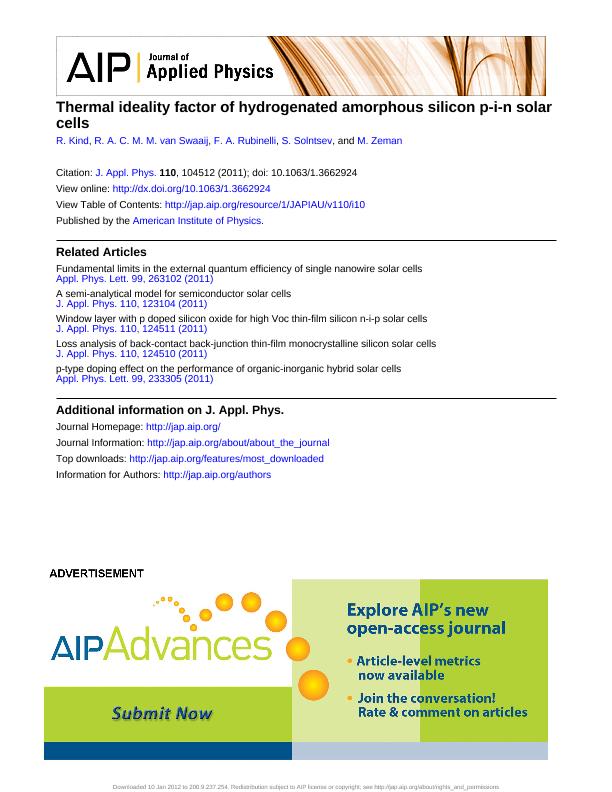Mostrar el registro sencillo del ítem
dc.contributor.author
Kind, R.
dc.contributor.author
Van Swaaij, R. A. C. M. M
dc.contributor.author
Rubinelli, Francisco Alberto

dc.contributor.author
Solntsev, S.
dc.contributor.author
Zeman, M.
dc.date.available
2017-02-14T20:18:30Z
dc.date.issued
2011-11
dc.identifier.citation
Kind, R.; Van Swaaij, R. A. C. M. M; Rubinelli, Francisco Alberto; Solntsev, S.; Zeman, M.; Thermal ideality factor of hydrogenated amorphous silicon p-i-n solar cells; American Institute Of Physics; Journal Of Applied Physics; 110; 11-2011; 104512-104512
dc.identifier.issn
0021-8979
dc.identifier.uri
http://hdl.handle.net/11336/13002
dc.description.abstract
The performance of hydrogenated amorphous silicon (a-Si:H) p-i-n solar cells is limited, as they contain a relatively high concentration of defects. The dark current voltage (JV) characteristics at low forward voltages of these devices are dominated by recombination processes. The recombination rate depends on the concentration of active recombination centers and the recombination efficacy of each of these centers. The first factor causes the ideality factor of the devices to be non-integer and to vary with voltage. The temperature dependence of the dark current can be expressed by its activation energy. For microcrystalline silicon solar cells the activation energy varies with voltage with a so-called thermal ideality factor of 2. This value was derived for devices with a spatially uniform defect distribution and reflects the recombination efficacy. Here we present results of a thickness series of a-Si:H p-i-n solar cells. We have matched the experimental curves with computer simulations, and show that the voltage-dependent ideality factor curve can be used to extract information on the cross sections for electron and hole capture. Also, the activation energy is used as a measure for the mobility gap, resulting in a mobility gap for a-Si:H of 1.69 eV. We find a thermal ideality factor close to 2 for all samples. This is explained with a theoretical derivation, followed by a comparison between the internal electric field strength and the spatial variation of the defect density in the intrinsic layer. The thermal ideality factor is shown to be insensitive to the defect distribution and the recombination profile in the device. It is, therefore, an appropriate parameter to characterize a-Si:H p-i-n devices, providing direct insight on the recombination efficacy.
dc.format
application/pdf
dc.language.iso
eng
dc.publisher
American Institute Of Physics

dc.rights
info:eu-repo/semantics/openAccess
dc.rights.uri
https://creativecommons.org/licenses/by-nc-sa/2.5/ar/
dc.subject
Amorphous Silicon
dc.subject
Dark Current Voltage Curves
dc.subject
Solar Cells
dc.subject
Thermal Ideality Factor
dc.subject.classification
Ingeniería Eléctrica y Electrónica

dc.subject.classification
Ingeniería Eléctrica, Ingeniería Electrónica e Ingeniería de la Información

dc.subject.classification
INGENIERÍAS Y TECNOLOGÍAS

dc.title
Thermal ideality factor of hydrogenated amorphous silicon p-i-n solar cells
dc.type
info:eu-repo/semantics/article
dc.type
info:ar-repo/semantics/artículo
dc.type
info:eu-repo/semantics/publishedVersion
dc.date.updated
2017-02-09T13:51:44Z
dc.journal.volume
110
dc.journal.pagination
104512-104512
dc.journal.pais
Estados Unidos

dc.journal.ciudad
Argonne
dc.description.fil
Fil: Kind, R.. Delft University of Technology; Países Bajos
dc.description.fil
Fil: Van Swaaij, R. A. C. M. M. Delft University of Technology; Países Bajos
dc.description.fil
Fil: Rubinelli, Francisco Alberto. Consejo Nacional de Investigaciones Científicas y Técnicas. Centro Científico Tecnológico Santa Fe. Instituto de Desarrollo Tecnológico para la Industria Química (i); Argentina
dc.description.fil
Fil: Solntsev, S.. Delft University of Technology; Países Bajos
dc.description.fil
Fil: Zeman, M.. Delft University of Technology; Países Bajos
dc.journal.title
Journal Of Applied Physics

dc.relation.alternativeid
info:eu-repo/semantics/altIdentifier/doi/http://dx.doi.org/10.1063/1.3662924
dc.relation.alternativeid
info:eu-repo/semantics/altIdentifier/url/http://aip.scitation.org/doi/10.1063/1.3662924
Archivos asociados
